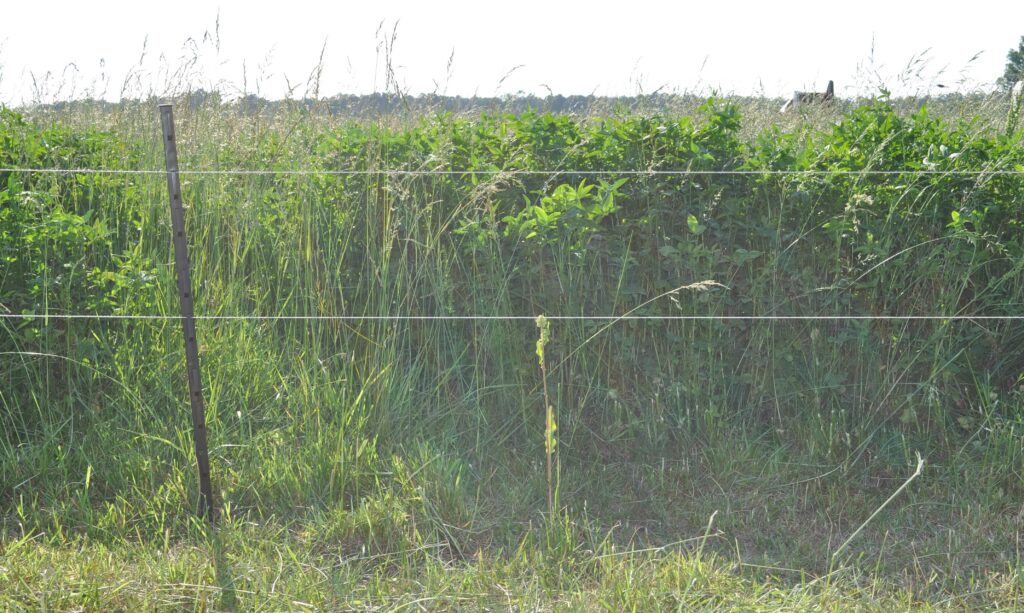Stockpiling Forage for Winter Grazing
go.ncsu.edu/readext?1017696
en Español / em Português
El inglés es el idioma de control de esta página. En la medida en que haya algún conflicto entre la traducción al inglés y la traducción, el inglés prevalece.
Al hacer clic en el enlace de traducción se activa un servicio de traducción gratuito para convertir la página al español. Al igual que con cualquier traducción por Internet, la conversión no es sensible al contexto y puede que no traduzca el texto en su significado original. NC State Extension no garantiza la exactitud del texto traducido. Por favor, tenga en cuenta que algunas aplicaciones y/o servicios pueden no funcionar como se espera cuando se traducen.
Português
Inglês é o idioma de controle desta página. Na medida que haja algum conflito entre o texto original em Inglês e a tradução, o Inglês prevalece.
Ao clicar no link de tradução, um serviço gratuito de tradução será ativado para converter a página para o Português. Como em qualquer tradução pela internet, a conversão não é sensivel ao contexto e pode não ocorrer a tradução para o significado orginal. O serviço de Extensão da Carolina do Norte (NC State Extension) não garante a exatidão do texto traduzido. Por favor, observe que algumas funções ou serviços podem não funcionar como esperado após a tradução.
English
English is the controlling language of this page. To the extent there is any conflict between the English text and the translation, English controls.
Clicking on the translation link activates a free translation service to convert the page to Spanish. As with any Internet translation, the conversion is not context-sensitive and may not translate the text to its original meaning. NC State Extension does not guarantee the accuracy of the translated text. Please note that some applications and/or services may not function as expected when translated.
Collapse ▲The practice of stockpiling grass for use at a later date is nothing new. It is exactly what producers do every time they make a bale of hay. The grass is allowed to grow to a certain stage and then harvested and stored away for use during the winter. This practice is costly and labor intensive both at haying time and when feeding. In an effort to reduce costs, many producers have looked for ways to cut down on feeding hay. Some have tried putting the bales out in various locations in the pastures and limiting the access to the pastures with fencing, sort of strip grazing bales of hay instead of pasture. It cuts out some of the labor but still requires making hay. Others decided on stockpiling pastures. Western cattle ranchers have been stockpiling native prairie grass meadows (pastures) for years. Stockpiling pastures is the same general principal as haying, except we store the grass in the field uncut and we intend for the cattle to do the harvesting.
When a producer talks about stockpiling, he generally thinks of fescue. While this is the best and most often used grass for stockpiling, almost any forage can be used. The forage species chosen for stockpiling will determine the time of use as well as when and how much supplementation will be needed. No matter which forage is used, cattle will need access to a good quality mineral supplement at all times.
Fescue, as stated above, is the most widely used and best suited forage for stockpiling. The pasture should be taken down to about four inches in height by mid to late August and 50 to 75 pounds of nitrogen per acre applied. With adequate rain producers should see rapid growth. The forage is then allowed to continue growing until needed for winter. If stockpiling a fescue pasture that has a lot of clover, little if any nitrogen will be needed to get adequate fall growth. These fields should be grazed in late fall or early winter, before pure fescue stands, because the clover will die out as we start getting frosts. Strip grazing will be needed otherwise too much forage will be trampled and defecated on and refused. Stockpiled fescue, and other cool season perennials, will adequately meet the requirements of lactating cows with moderate milk production. It will exceed the needs of dry, gestating cattle. Growing calves and heifers will need some supplementation to attain adequate performance. In our area, there isn’t an abundance of fescue. There is however, a huge supply of bermudagrass. In response to this, producers have asked about the possibility of stockpiled bermudagrass for winter grazing.
Bermudagrass is probably the least desirable for stockpiling but can be used. The bermudagrass should be clipped short, either by haying, grazing, or mowing, by late August or early September. Fifty to one hundred pounds per acre of nitrogen should be applied and the grass allowed to grow through the month of September. Grazing should begin mid to late October and the grass used up by the end of the year. Use stockpiled bermudagrass before moving cattle to cool season forages. Strip grazing will be necessary to get maximum utilization of the forage. Research in Oklahoma has indicated that stockpiled bermudagrass will support a dry, gestating beef cow without supplementation through November. Protein supplementation should begin in December if there is still sufficient forage for the cattle. Lactating cows and growing cattle will need to be supplemented with some form of protein from the onset of grazing the stockpiled forage. Dallisgrass can also be stockpiled following the same procedure for bermudagrass but approaches fescue in animal performance.




